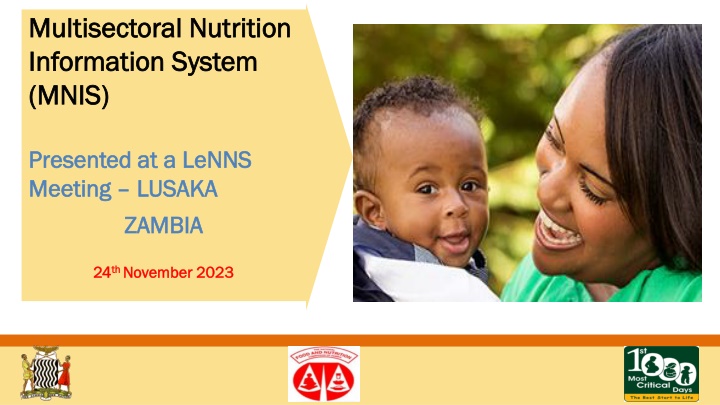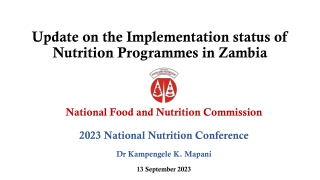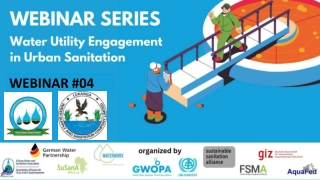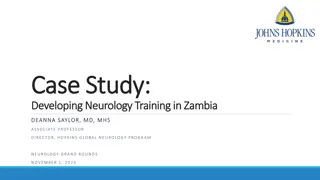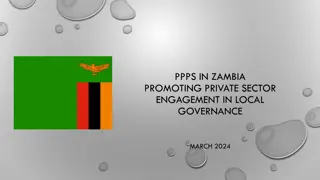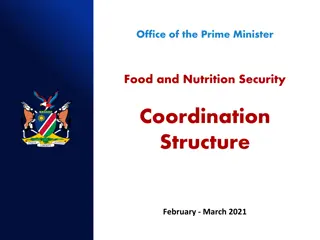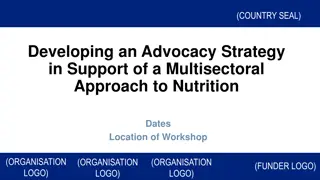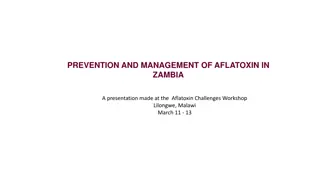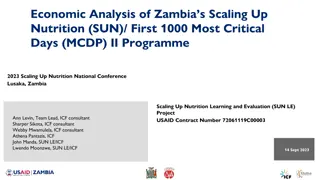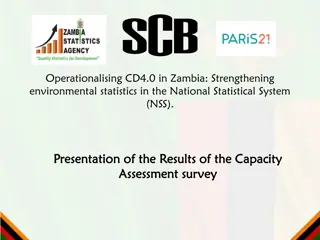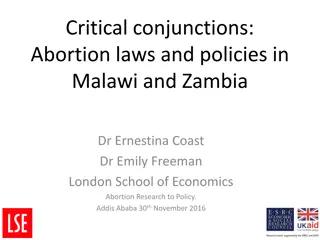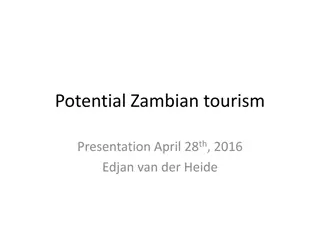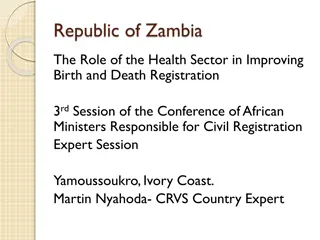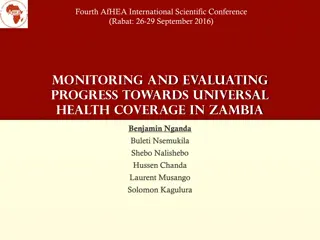Enhancing Multisectoral Nutrition Coordination in Zambia
The Multisectoral Nutrition Information System (MNIS) presented at a LeNNS meeting in Lusaka highlights the importance of a multisectoral approach to address nutrition challenges in Zambia. The coordination structures, evidence, and recommendations emphasize the need for collaborative efforts, adequate financing, and prioritization of nutrition interventions to achieve development goals. Strengthening roles, responsibilities, and linkages between public health and clinical nutrition is key for success.
Download Presentation

Please find below an Image/Link to download the presentation.
The content on the website is provided AS IS for your information and personal use only. It may not be sold, licensed, or shared on other websites without obtaining consent from the author.If you encounter any issues during the download, it is possible that the publisher has removed the file from their server.
You are allowed to download the files provided on this website for personal or commercial use, subject to the condition that they are used lawfully. All files are the property of their respective owners.
The content on the website is provided AS IS for your information and personal use only. It may not be sold, licensed, or shared on other websites without obtaining consent from the author.
E N D
Presentation Transcript
Multisectoral Nutrition Multisectoral Nutrition Information System Information System (MNIS) (MNIS) Presented at a LeNNS Presented at a LeNNS Meeting Meeting LUSAKA LUSAKA ZAMBIA ZAMBIA 24 24th th November 2023 November 2023
Presentation objectives Multisectoral Nutrition Coordination Structure Multisector Activity Report Form (MARF) where we are coming from. the objectives of MNIS, its framework, and reporting structure MNIS data entry, data sources, data flow, and timelines of reporting. MNIS Implementation progress Conclusions
Zambia Nutrition Coordination Structures Zambia Nutrition Coordination Structures Available evidence (Lancet 2013) shows that nutrition impacts every aspect of human development The determinants of malnutrition are multifaceted and to address nutrition challenges requires multisectoral approach A nutrition multisectoral approach, is a logical range of plans that enhances food and nutrition security through a convergence of interventions: (agriculture, health, clean water, sanitation and hygiene, education etc.) In Zambia, Multisectoral programming has been strengthened by SUN Collective effort is required to improve multisectoral approach in nutrition
Zambia Nutrition Coordination Structures Zambia Nutrition Coordination Structures Investing in nutrition is fundamental to achieving Zambia s development goals Multi-sector programming is challenging, complex and takes time: it needs; Strong coordination, Collaboration, planning, monitoring and evaluation Convergence of interventions Adequate financing, accountability and commitment Prioritise nutrition interventions Understanding and strengthening roles and responsibilities Strengthen the linkage between public health nutrition to clinical nutrition
Multisector Activity Report Form Multisector Activity Report Form - - Where we are coming from coming from A harmonized excel/paper- based district multisectoral aggregation reporting tool, for subnational routine data collection and reporting to the national level. The MARF was designed by adapting existing tools across the implementing six sectors (MoH, MCDSS, MoA, MWDS, MoE, Cross cutting. Where we are District Multisectoral Activity Report Form WASH INTERVENTIONS - ACTIVITY REPORT FORM Province: District: Report date: Report Period: Report compiled by: Name: Position: Phone number: Email: Annual Target Total Number Achieved Themes and Indicators Disaggregate Male Female Male Male Male Female Male Female Male Female DNCC 111. # of government/sector staff trained in water, sanitation and hygiene WNCC District staff Sanitation Action Group (SAG) members 112. # of community participants trained in water, sanitation and hygiene CCs/CHWs
MARF MARF - - Where we are coming from Where we are coming from Cont d Cont d MARF Data sources - sector MIS (e.g. the DHIS2) and reports, including other activity specific SUN reporting tools. All SUN/MCDP II implementing sectors and partners/CSOs were reporting to NFNC using the relevant component of the MARF, after the end of the quarter All output indicators on the MARF relating to the SUN/MCDP activities implemented in the quarter were reported on.
Challenges with MARF Challenges with MARF Data quality - Reporting same figures for two quarters Lack of Sector reporting tools. Roles of different players not properly defined in the reporting process NGOs, Sector HoDs, DNCC, PNCC, CPs.
MNIS Background MNIS Background MNIS is an integrated web based system used by NFNC, partners, and stakeholders to collect relevant and functional information on a routine basis aimed at monitoring the Nutrition Sector indicators to enable planning, decision making, M&E of the Nutrition intervention. Goal of MNIS - To provide quality data that supports evidence-based decision making at all levels of the nutrition programme. It was developed by NFNC and Partners with financial support from UNICEF
MNIS Background MNIS Background Cont d Cont d A Comprehensive Needs Assessment to review and assess existing nutrition M&E frameworks, review the management information system infrastructure was conducted. Stakeholder consultations including UNICEF, NFNC, M&E TWG, DNCC, WNCC, line ministries, sectoral stakeholders, SUN TA, FANSER, among others. Reviewed and revised the Nutrition indicators Developed the data collection tools Developed the MNIS
Objectives and benefits of MNIS Objectives and benefits of MNIS Enables data entry and reporting at various levels and for different reporting cycles. Provides quality data to support evidence-based decision making in the nutrition sector Assist in assessing performance at all levels of the nutrition sector Facilitates data use and sharing with stakeholders at various levels. Can be used to collect data for nutrition interventions in all districts in the country.
Districts where MNIS is being implemented Districts where MNIS is being implemented PROVINCES (7) DISTRICTS (17) Lusaka Province Lusaka Chongwe Eastern Province Chipata Lundazi Muchinga Province Chinsali Isoka Mpika Luapula Province Chiengi Southern Province Choma Monze Western Province Mongu Kalabo Kaoma Shangombo N. Western Province Solwezi Zambezi Mwinilunga
Integrated Data Repository Integrated Data Repository National Food and Nutrition Commission Ministry of Health Community Development and Social Services Ministry of Education Ministry of Agriculture MNIS Ministry of Water Development and Sanitation Ministry of Green Economy and Environment Ministry of Local Govt and Rural Development / Local Authorities Ministry of Fisheries and Livestock
MNIS MNIS An Integrated Nutrition Data Warehouse An Integrated Nutrition Data Warehouse
MNIS Log in to the system Landing page - https://nmis.nfnc.org.zm A landing page as shown below should show. If you don't see this page, please clear your browser history and try again.
MNIS Log in to the system - Usernames and passwords To access the database, you need to have a username and password provided by the system administrator. Account Usernames are email addresses Generic password is: Nfnc@2023 Once you log in, change password and update your account in terms of personal information If you are unable to access the system use: username: test password: Nfnc@2023
Navigating from the top menu access to the modules Clicking on the App Launcher displays more operational features like data entry, data quality and reporting
Data Entry Process contd) Data Entry Process cont d) .
Data Entry Process contd) Data Entry Process cont d)
MNIS Datasets MNIS Datasets
Data Collection Tool Example Data Collection Tool Example - - NSG NSG
Data is collected at community and ward level using paper-based tools The paper-based reports are sent to district level for data quality checks and entry into the MNIS How data collection is conducted Provincial level also conducts quality checks and accept/reject the data Health & Nutrition indicators under MoH follow the current data reporting structure. MNIS is linked to the Nutrition component of the HMIS
MNIS Data Flow The MNIS is accessible by relevant key line Ministries and NFNC stakeholders at the district, province and national levels While most data collection is conducted using paper tools at the household and community levels, data is entered into the MNIS at the district level This is to facilitate analysis of results down to the community level, national-level reporting, and to enable more meaningful and evidence- supported appraisal of the results of nutrition programming across Zambia
Roles and responsibilities Roles and responsibilities Provincial - Reviews data in MNIS for completeness, quality and accuracy, presents it in the PNCC National - Reviews, approves and shares all the data to stakeholders and line ministries Sub-district - Collects and aggregates the data from community, household level and implementation sites sends to the district District - Aggregates, reviews and enters data into the MNIS, presents it in the DNCC
MoA MoA Data Flow Chart Data Flow Chart
Nutrition Data Sources and Flow Nutrition Data Sources and Flow
DATA ANALYSIS DATA ANALYSIS - - Data Visualizer Data Visualizer The data visualizer module enables users to create dynamic data analysis and visualizations through charts, pivot tables, data tables and dashboards.
Data Visualization & Dashboards Data Visualization & Dashboards
MNIS Documentation MNIS Documentation MNIS manual: A Standard Operating Procedure (SOP) on getting access to the system is in place. Data collection tools: This contains all relevant primary data collection tools by sector, tailored to provide data for each indicator. M&E Framework and Operational Guide: This contains indicator definitions, methods of data collection, frequency, calculation, and interpretations.
MNIS Users MNIS Users National (Trainer of Trainers) Line Ministry Nutrition Focal point persons, M&E Officers, NGO project managers, NGO M&E officers, UN Partners Provincial - NFNC PNSC, NGO Provincial M&E, Line Ministries District - NFNC DNSC, District M&E, NGO Staff, NSG Supervisor, Partners Districts, Line Ministries
MNIS Implementation progress MNIS Implementation progress Review and finalisation of indicators by sector conducted with line ministries and partners Review and finalisation of data collection tools conducted with line ministries and partners. Tools shared with the districts for printing and distribution to the sub district level. Trained the national partners (National ToT) Line ministries, NGOs, Partners
MNIS Implementation progress MNIS Implementation progress Cont d Cont d National trainers trained the districts in 17 districts Line ministries, NGOs, Partners Districts then trained the sub district level and community levels National MIS managers created district usernames Field testing of the MNIS Establishing and launching the system
Challenges Challenges Sustainability resources required to maintain the MNIS Limited funding for M&E activities such as technical supervision, capacity development, conducting of review forums and integration of technology in the M&E system Inadequate stakeholder co-ordination for M&E and accountability mechanisms Understaffing and inadequate capacity for nutrition and M&E staff both at the national and district levels Gaps in technical knowledge in M&E and ICT as a result of inadequate capacity development and technical supervision
Conclusions MNIS will strengthen and improve the implementation of M&E and quality of the nutrition data, in terms of comprehensiveness, reporting and utilization Improve multi-sectoral coordination, technical supervision, capacity building on M&E and NIS, dissemination and utilization of M&E data MNIS provides potential opportunities for nutrition information and Liaison with DHIS2 MoH, Liaison with UN partners and NGOs and scale up to other projects/provinces Explore possible networking with different partners for strengthening of the govt nutrition and food security
